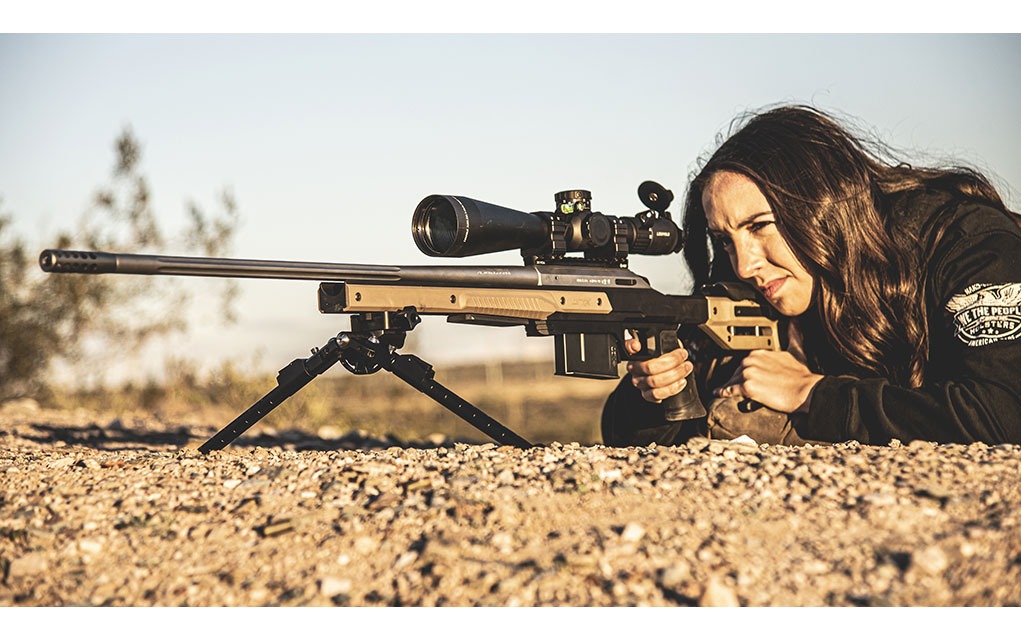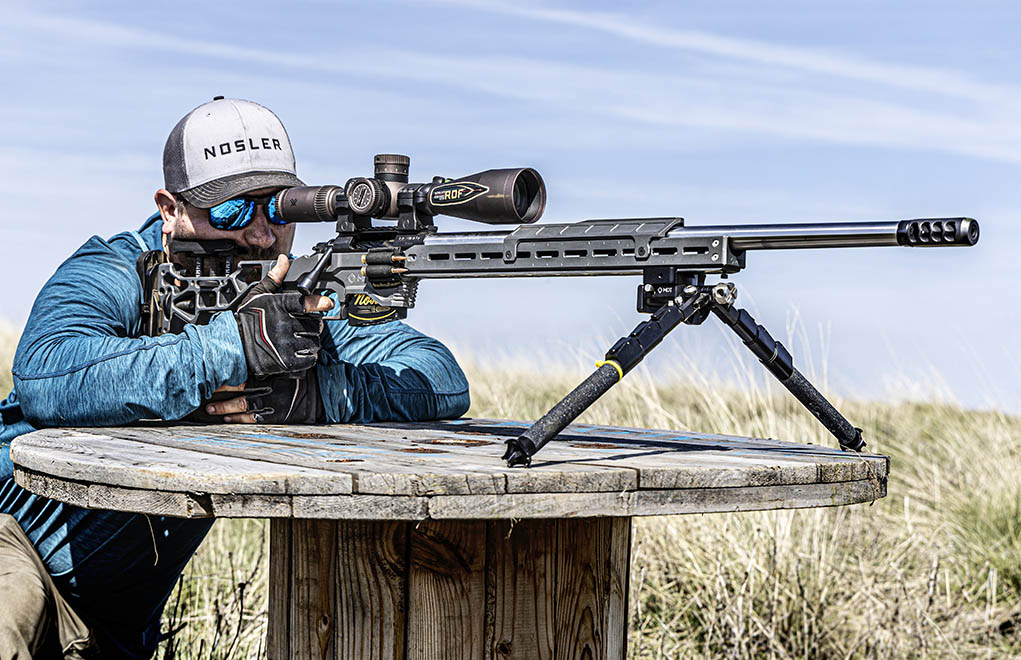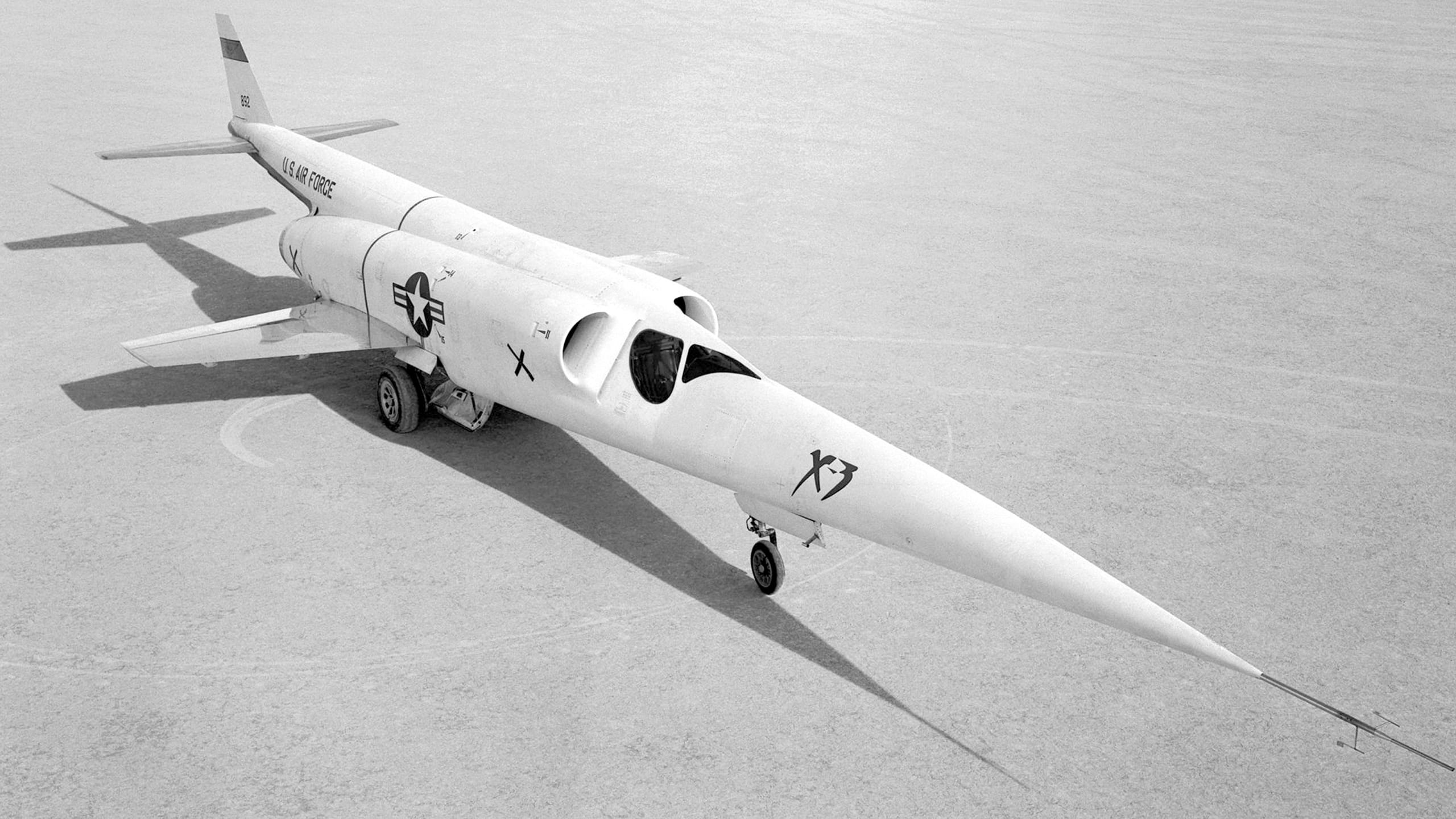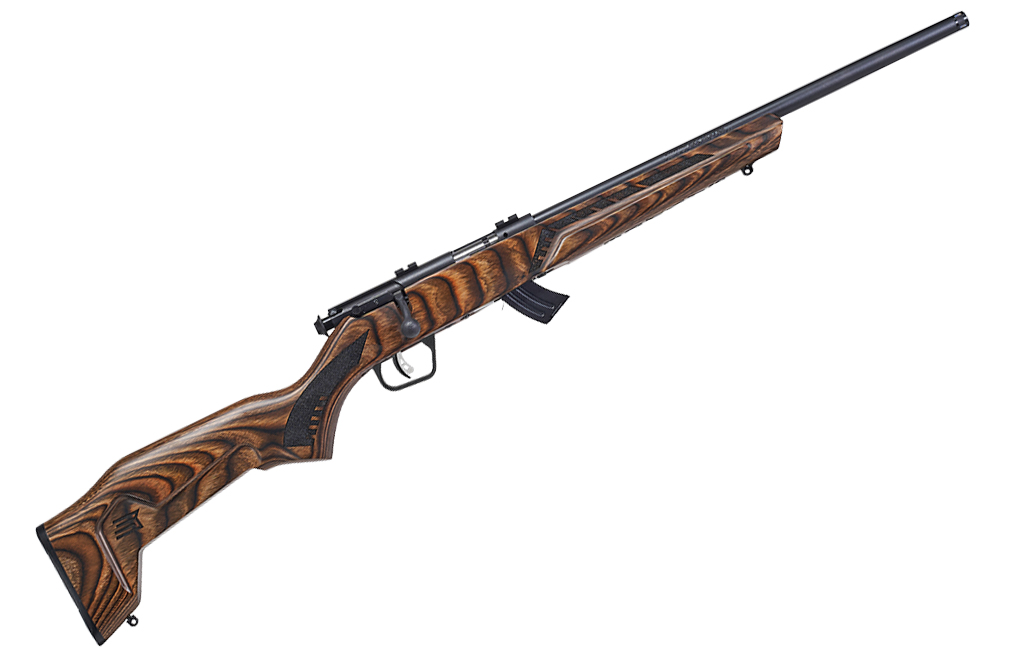Heavy target rifles with high-powered scopes have become extremely popular, but are they too much gun for backcountry hunting?
Hunting in the Santa Fe National Forest North of the Valles Caldera National Preserve, I was in hot pursuit of elk. My scouting efforts had proved fruitful, locating elk herds feeding in the meadows and on the ridges. Weeks later, when it came time to hunt, the drought had scattered the animals into small herds, which held tight to the trees, even at dusk and dawn. I’d planned to hike several miles and glass the canyons and meadows from multiple vantage points, and I was prepped for a long-range shot.
Attached to my pack was a custom Tikka T3 chambered in 6.5 PRC with a heavy barrel, MDT XRS Chassis, Tract Toric UHD 4-20x riflescope, and suppressor, the ideal setup for longer shots. On day one, after 14 miles of hiking and glassing numerous valleys and canyons, I didn’t see a single herd of elk save for the occasional one I jumped in the oak scrub or aspens. While quietly creeping through the bush, I would hear a commotion as a lone elk would run through, giving me mere seconds to acquire a target and try for an ethical shot. The animals were usually within 50 yards. However, I could not swing the bulky rifle and acquire a target quickly enough, even with the scope dialed down to 4 power. This trend would repeat itself.


After walking nearly 30 miles, I wondered if I was taking too much rifle and scope into the wilderness. Walking back to my SUV in the dark, I spent hours contemplating something like an AR-15 6.5 Grendel build with a 1-8x low-power variable optic (LPVO) or even a lightweight bolt gun with a simple red-dot for hunting the bush.
Fast-forward a few weeks, and I was chasing mule deer in the Lincoln National Forest, carrying the same rifle. The terrain was rugged and rocky and had a mixture of cedar, piñon, and juniper trees. After a 6-mile hike, my hunting partner, Mark, and I came across a herd of bucks grazing on the side of a mountain. Using a small pine tree as an improvised monopod, Mark harvested an excellent buck at 270 yards. While walking along a ridge line the following day, we found a small group of deer, and I shot the lone buck at 140 yards.
From the shadows, I took a seated position, deployed my MDT Triple-Pull CKYE-Pod bipod, settled in, found my target, exhaled and sent a 147-grain Hornady round into the cranial vault of the cervid. After securing the rifle, saying prayers and doing a quick photo shoot, we harvested the meat using the gutless method and hiked back to the truck. Before we hiked out, I took out my rangefinder and ranged the surrounding hills and peaks. Conceivably, my farthest shot would have been 400 yards. Once again, I wondered if I was taking too much rifle into the woods.
The Journey
My journey into long-range shooting started around 2010 when I picked up a Remington 700 SPS Tactical to get a handle on the coyote population at the family ranch in Central New Mexico. Since then, I’ve devoted significant time to mastering precision rifle shooting, and I will readily admit that I see all aspects of shooting, even pistol, through the lens of ultra-precision. I regularly train to 1,000 yards and occasionally shoot steel to 2,500 yards if testing a new cartridge or long-range shooting technology.
Though I don’t see myself as a long-range hunter or advocate for long shots on large game, the mastery of a precision rifle and the ability to hit targets at long distances increases confidence. It familiarizes you with all aspects of your rifle system and ancillary gear. The ability to hit targets at medium and long range is a valuable tool in your hunting toolbox. Is a trophy buck standing broadside at 500 yards? Get prone, acquire the range and atmospheric data, and send it. Hit an animal at 300 yards, then have it reappear at 600 yards on the adjacent canyon? Consult your ballistic calculator and send a round with confidence.
I spent years shooting varmints and steel targets at long range before getting serious about hunting big game. Initially, I was obsessed with having a match-grade rifle capable of shooting at least a ½-MOA group. These rifles were usually mated to a Modular Driven Technologies or Kinetic Research Group chassis system and typically weighed around 12 to 14 lbs. The rifles would have a heavy barrel and a large, high-magnification riflescope. I typically used rounds with a high ballistic coefficient, like the 6.5 Creedmoor or 6.5 PRC, and the rifles were capable of sub-MOA groups. How did I manage to lug the weight on long hikes? Fitness, a stable pack and a good sling helped immensely, though admittedly, after three days into an elk hunt, a heavy rifle was only fun if you had an ATV or horses.
After my elk and deer hunt, I thought about every large game hunt I had been on or guided. All of the deer I have harvested have been within 200 yards. Most of the engagements were quick: I spotted the animal, steadied myself, and took a well-aimed shot from a tripod, trekking poles, or the kneeling position. I assume animals have insanely good vision and sense of smell, but I am astounded by how close I have gotten to deer and elk while hunting.


Varmint hunting is a different story. I’ve shot prairie dogs and coyotes between 600 and 800 yards. The most incredible shot I attempted was on a coyote at 1,820 yards, though I missed it by mere feet. The antelope hunting clients at our ranch, whom I formally trained in precision rifle and had Kestrel ballistic calculators with data confirmed to 1,200 yards, have made some great shots. However, the farthest to date was 450 yards, a perfect broadside shot with a 6.5 Creedmoor that instantly dropped that animal. Depending on the time and terrain, I will always try to get closer; I have just never had to.
Long-range shooting and precision rifle competition have created many new hunters who often carry something analogous to their competition or long-range rig, which is how I came into the sport. This leads me to ask: Are some sportsmen taking too much rifle into the woods? Do we need the high magnification scopes, 24-inch barrels, and the new-fangled high-BC bullets? On a more personal note, do I need the heavy barrel, suppressor, chassis system, and insane accuracy? Let’s explore these questions.
Barrel Length and Weight
For this section, we’ll consider anything below a 20-inch barrel to be a short barrel. There are zero questions about it: A long barrel on a rifle is awesome. It maximizes velocity and kinetic energy and flattens trajectories at typical hunting ranges.
Rifles with sporter or thin-contour barrels don’t weigh much. Still, they can have high accuracy when paired with the correct factory load or handload. When shooting groups with an accurate sporter barrel, I can get two rounds to touch, and then the third shot is usually .50 to 1 inch from the first two holes. I’ll let the rifle cool for 10 minutes, then shoot another group. This will play out multiple times before I consider the rifle zeroed. (If you put a muzzle brake on a rifle, hearing protection is mandatory since the sound directed toward the shooter will cause permanent hearing loss, even after one shot.)


Heavy varmint or match barrels have excellent harmonics and, when paired with the proper ammunition, can usually shoot very tight 3- or 5-round groups. They’re purpose-built for accuracy but heavy. A rifle with such a barrel is fine for backcountry hunting if you have mobility platforms like e-bikes, horses or ATVs. The weight can mitigate recoil, though I still like a brake for spotting hits and fast follow-up shots. Heavy barrels are super easy to zero. I’ve hunted with heavy 16- and 20-inch barrels, which are awesome to pair with a suppressor.
In theory, a carbon-fiber-wrapped barrel offers the best of both worlds. It features a thin barrel wrapped in carbon fiber, and manufacturers claim it can produce results typical of a heavy contour with reduced weight. My experience with carbon-wrapped barrels has been hit-and-miss. Some shoot excellently with factory ammunition, but when you add a muzzle device, groups open up like crazy. Tuners and handloading are a good idea if you’re considering one.
Whether you have a thin sporter or heavy barrel, how much length do you need? To answer this, ask yourself a few questions. What kind of zero do you use? For example, do you zero at 100 yards and dial or use a reticle for longer shots? Do you zero 1 or 2 inches high at 100 and point and shoot out no farther than a determined range, such as 300 yards? A long barrel is advantageous if you use the latter because the high velocity will give you a flatter trajectory.
If you zero at 100 yards, dial or hold your shots in your reticle, understand how to use a ballistic calculator, and confirm your data at the distances you intend to harvest animals, barrel length doesn’t matter as much. What matters is that you have enough energy and velocity to dispatch your quarry ethically.
Short Barrels
Modern hunting bullets need a certain velocity to expand reliably, causing crush injuries that damage an animal’s organs, circulatory and nervous systems. Your bullet’s kinetic energy when making contact with the animal is also vital. How much velocity do modern bullets need to expand reliably? That will vary by manufacturer, but modern hunting projectiles usually need a minimum of 1,700 fps to expand reliably. Though up for debate, a minimum of 1,000 ft-lb is a decent amount of energy for deer-sized animals and at least 1,500 ft-lb for elk.
Energy and velocity aside, an important variable is shot placement. This became apparent when I saw a video of my buddy dropping a bull elk at 600 yards while using a 6mm Creedmoor match round fired from his PRS competition rifle. It was a perfect shot through the heart. Do most hunters have the skill, training, and gear to make perfect shots at 600 yards? Probably not. Another variable to contend with is wind, which can be hard to ascertain in certain locations. Also, large game animals are tough and adapted to harsh climates and predators. They are an amalgamation of sinew, bone, water, muscle and hide.
Sometimes, bullets don’t perform like they should, especially when they contact bone. Shot placement is critical, but it’s nice to back it up with a fast bullet and kinetic energy. With that said, when I run the numbers on my ballistic calculator to determine the performance of a cartridge, I like 1,800 fps at a minimum and 1,000 ft-lb for deer-sized animals. Now that we have established a baseline for velocity and energy, let’s look at barrel length, specifically short ones.
I appreciate short barrels for my ranch and hunting rifles. They are handy, compact and easy to carry. Since I often hunt with suppressors, starting with a shorter barrel doesn’t substantially increase the overall length of my rifle system. Suppressors mitigate recoil and allow me to hunt without hearing protection.
I’ve always liked short barrels due to their compact nature and accuracy. Still, several years ago, I cut one of my Howa 1500 barreled actions chambered in 6.5 Creedmoor down to 16 inches and was curious about its external ballistics. After running some Hornady 143-grain ELD-X Precision Hunter rounds through my Labradar chronograph, I recorded an anemic average of 2,498 fps. Plugging the data into my Kestrel anemometer, I was surprised by the numbers. Even with the low muzzle velocity, I had 1,800 fps and 1,082 ft-lb of energy out to 800 yards. I would never shoot at an animal at that range, but even at a realistic distance, like 500 yards, I had 2,078 fps and 1,372 ft-lb of energy.
Regarding long-range shooting, some bullets can lose gyroscopic stability at the transonic range, which starts at around 1,350 fps. My Kestrel told me I could expect decent performance from my weapon system out to 1,500 yards at my density altitude. To test it, I proned out and easily got a second-round hit at 1,000 yards. After hitting steel at 1,000 yards, I aimed at the 12-inch steel target (on which I trued my ballistic coefficient) and had a first-round hit at 1,250 yards.
For comparison, I grabbed another Kestrel with the data for one of my .308 rifles with a 24-inch barrel. The rifle was zeroed and trued for Hornady 178-grain ELD-X Precision Hunter loads. Consulting the ballistic chart, I was looking for the 1,800 fps and 1,000 ft-lb band and found it around 800 yards. My .308 had 1,852 fps and 1,356 ft-lb of energy at that distance. Granted, it had more energy due to the weight of the bullet, but I was impressed by what a slower, higher-BC bullet could do. From this experiment, I found that a 16-inch barrel has plenty of velocity and energy for hunting shots to 600 yards. (For more information about ballistics, I recommend reading The Ballistics Handbook by Philip P. Massaro.) Now, it was time to take a deep dive into optics.
Optics
Back to my conundrum: Was I taking too much rifle and scope into the woods? To answer this question, I built the perfect rifle for hunting thick forests and aspen groves. It could also reach across a canyon and hit something at 500 yards if necessary. For the build, I grabbed an old Tikka T3 barreled action chambered in .308 Winchester, with a barrel cut down to 16.1 inches. I dropped the barreled action into an HNT26 Chassis System from MDT and attached a Tract Toric UHD 30mm 1-8×24 LPVO scope. At the end of the muzzle, I attached a SilencerCo Harvester EVO suppressor and, for added stability, the MDT GRND-POD bipod. The System as a whole weighed just under 7 pounds.
Since the Tikka had a 1:11-inch twist rate, I opted for Hornady 168-grain ELD-M bullets with a G1 BC of .523. Settling behind the rifle, I shot three rounds, made some adjustments, let the rifle cool, and then fired three more rounds. Even though I only had an 8x scope, I could shoot groups of just under 1 MOA, and the Labradar chronograph gave me an average velocity of 2,502 fps.


Satisfied with my zero, I drove to the 2,000-yard range at our ranch, which had a steady left-to-right wind averaging between 12-15 mph that day. I hung a 10-inch steel gong and worked back in 100-yard increments. From 100 to 400 yards, I held in the reticle and had first-round hits on steel. My first miss came at the 500-yard line. After that miss, I dialed the elevation and made a solid hit. I dialed the 600-yard shot, had a first-round hit, and connected on my second shot at 700 yards. At 800 yards, I had difficulty seeing the target, so I ended the exercise. Consulting the range card in my Kestrel, I noted that at 600 yards, the 168-grain ELD-M traveled at 1,809 fps and had 1,221 ft-lb of energy. That’s plenty for deer, though the rifle was not intended to shoot that far.
The Hunting Test
After drawing a mule deer tag in Unit 37—where I’ve taken several nice mule deer—I was anxious to carry something other than a 12-pound rifle into the woods. I again pondered an AR-15 6.5 Grendel build with two upper receivers. One upper receiver would have a hunting scope, and the other a simple red-dot optic. However, that was quickly dismissed because of my excellent results with the Tikka T3 and the 1-8x scope. Moreover, the 6.5 Grendel is a tad light for mule deer and runs out of energy past 200 yards. Next, I pondered a Tikka T3x chambered in 6.5 Creedmoor with a red-dot sight, but the precision side of my brain insisted I take at least some magnification. Ultimately, I chose the Tikka T3 with the MDT HNT26 chassis I had built to see how far I could effectively shoot the 1-8x LPVO.
Due to my hectic schedule, I could only hunt for two days. On day one, I started at first light, creeping up a canyon with the riflescope on 1x. After several hours of careful hiking, I crested a ridge and saw a dozen deer resting in the shadows 50 yards away. I froze and slowly took out my binocular. All of the deer were doe, save for one barely legal buck. After watching for 30 minutes, I kept hunting and moved downhill to avoid disturbing them. I worked my way to the top of the canyon, where I settled on a vantage point that allowed me to glass multiple canyons. I saw dozens of deer moving to and from a spring at the bottom of the canyon, but nothing that I could shoot.
Taking out my rangefinder, I noted that the farthest deer was 400 yards away. I looked at the group through the 1-8x scope and was confident that, had a good-sized buck appeared, I could have easily harvested it with that setup. I spent the rest of the day glassing from that point and, with the sun setting, started the hike back to my vehicle.


As I was hiking down, I bumped into a group of deer at 10 yards. I quickly scanned the group but didn’t see a single legal buck. I watched as the animals bounded toward the ridgeline and then paused to look back at me. I continued my journey back to my vehicle and noted how lightweight the rifle was. Had a buck presented itself, I could have harvested it with ease. Day two was nearly identical, though a blizzard drove me off the mountain. I saw many deer and one small buck that was legal, though I passed on harvesting it. I hiked 15 miles and felt great because I carried a lightweight, nimble rifle.
Several weeks later, I accompanied some friends in the Chama to pursue mule deer. Due to the terrain and foliage, we found ourselves hunting a mix of sub-alpine forests, meadows, and mixed cedar, piñon, and juniper. One group member had a Howa 1500 chambered in 6.5 Creedmoor with an Arken EPL 4-16x riflescope, and the other member carried my lightweight Tikka. The logic was that we had rifles ideal for close and long shots. Though a deer wasn’t harvested, we learned a lot and had a great time.
Looking Forward
Since I rarely hunt alone, moving forward, I think one member of the team will have a 4-16x or a 6-24x riflescope for precise shots out to 600 yards, and one will carry a lightweight, compact rifle, suppressed, with a 1-8x or 1-10x scope. Why the suppressor? When sneaking through the bush, you want to use all of your senses, and if you have an animal trotting past, you often don’t have time to put on hearing protection. Suppressors also mask your sound signature and don’t bugger up the general area after you have taken a shot.
I will use my lightweight Tikka T3 with the MDT HNT26 Chassis System, or my heavier custom Tikka T3x chambered in 6.5 PRC for all future hunting. The custom Tikka features a 20-inch carbon-fiber-wrapped barrel from Oregon Mountain Rifle Company. I adore chassis systems and will continue to use them for the foreseeable future. I will usually grab the lightweight Tikka T3 unless I’m hunting plains animals. I like the challenge of the stalk and enjoy creeping through the trees and harvesting animals up close. The lightweight rifle allows me to carry extra food and sleep systems for backcountry hunts farther from the trailhead.
It’s been challenging not taking a heavy precision rifle capable of insane accuracy into the woods. Even so, my recent hunts showed that a shorter barrel and lower magnification scope can do the job and make close-up shots. If I draw a tag this year, I will once again take a lightweight, short-barreled rifle with a low-powered variable optic. Who knows? You may soon find me hiking around the woods with a red-dot optic or open sights!
Editor’s Note: This article is an excerpt of Gun Digest 2025, 79th edition.
More On Hunting Rifles:


Next Step: Get your FREE Printable Target Pack
Enhance your shooting precision with our 62 MOA Targets, perfect for rifles and handguns. Crafted in collaboration with Storm Tactical for accuracy and versatility.
Subscribe to the Gun Digest email newsletter and get your downloadable target pack sent straight to your inbox. Stay updated with the latest firearms info in the industry.
Read the full article here









![KE Arms Shotgun Picatinny Stock Adapter [FIRST LOOK] KE Arms Shotgun Picatinny Stock Adapter [FIRST LOOK]](https://www.recoilweb.com/wp-content/uploads/2025/01/KE-Arms-Shotty-3.jpg)


Leave a Reply